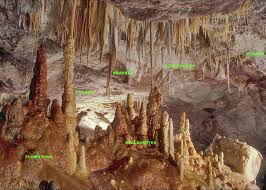stalagmite
英 ['stæləgmaɪt]
美 [stə'læɡmaɪt]
stalagmite 石笋来自拉丁语 stalagmites,石笋,向上生长的石柱,来自希腊语 stalagmos,滴落,滴下,来自 stalassein,滴,流淌,来自 PIE*stag,滴,渗出,词源同 stagnant,instill.拼写比较 rule,regulate. 其与 stalactite 的区别可能在于-ct 为-g 的过去分词格。
- stalagmite (n.)
- cone-shaped formation of carbonate of lime on the floor of a cave, 1680s, from Modern Latin stalagmites (1650s, Olaus Wormius), from Greek stalagmos "a dropping," or stalagma "a drop, drip, that which drops," from stalassein "to trickle" (see stalactite). Related: Stalagmitic; stalagmitical.
- 1. A stalagmite is below a stalactite and they both grow, eventually to meet.
- 石笋在钟乳石下面,它们二者都在增长, 最终会合.
来自辞典例句
- 2. This article reports on the study of an active stalagmite 18.
- 此研究表明洞穴石笋具有记录人类活动的能力.
来自互联网
- 3. There a highest stalagmite in the world - -- Dinghu Peak.
- 在那有世界第一高的石笋 --- 鼎湖峰.
来自互联网
- 4. A stalagmite . The cave is full of them.
- 石笋,这个洞穴里随处可见.
来自互联网
- 5. Not every stalactite has a complementary stalagmite.
- 不是每根钟乳石都有互生的石笋.
来自互联网
[ stalagmite 造句 ]
